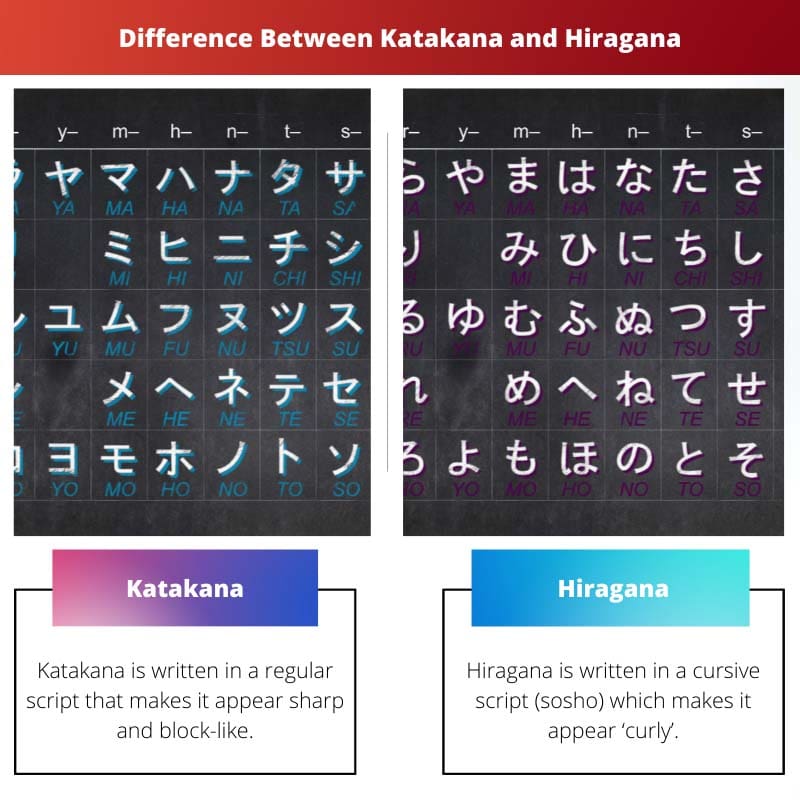Katakana and Hiragana are essentially two groups of the Japanese alphabet. They are syllabaries, meaning that they are set of alphabets that represent the syllables of various words.
This is a popular method that helps people know how to pronounce different words and letters. However, there are several differences between the two groups.
Key Takeaways
- Katakana is used to write foreign words and names, while Hiragana is used to write Japanese words and grammatical elements.
- Katakana is primarily used for words borrowed from other languages, while Hiragana is used for verb endings, particles, and suffixes.
- Katakana is used for emphasis or for giving a modern or fashionable feel to the text, while Hiragana is used in everyday writing and reading.
Katakana vs Hiragana
Hiragana is a syllabary consisting of 46 basic characters, each representing a distinct sound in the Japanese language, used to write native Japanese words, particles, and grammatical elements. Katakana is a syllabary consisting of 46 basic characters used to write loanwords from foreign languages.

Katakana is written in a regular script, making it appear sharp and block-like. It is used for words that are foreign, meaning that they have been taken from other languages.
This alphabet set is used to bring about an effect of emphasis and sometimes even for a stylish appearance. However, it is avoided in formal settings.
Meanwhile, Hiragana is written in a cursive script (sosho), making it appear ‘curly’, just like English Cursive makes words look slightly slanted and curly. It is used for native words that have their origins in the Japanese language.
This is the simplest way to write things down in Japanese. It is also very popular in formal settings.
Comparison Table
| Parameters of Comparison | Katakana | Hiragana |
|---|---|---|
| Meaning | It is a syllabary that is used for foreign words taken largely from the Chinese and Korean languages. | It is a syllabary that is used for native words that have their origins in the Japanese language. |
| Script | It is written in regular scripts (kaisho). | It is written in cursive scripts (sosho). |
| Appearance | It has a sharp and block-like appearance. | It has a slanted and curly appearance. |
| Uses | It is used to give stylish effects and emphasis but is not used in formal settings. | It is the most simple and common way of writing and is extensively used in formal settings. |
| Notation | It is very commonly used as a phonetic notation. | It is very commonly used as a grammar notation. |
What is Katakana?
Katakana is a set of alphabets used in the Japanese language for words taken from foreign languages. These largely include words from the Chinese, Korean, and even English languages.
However, they are only used informally for stylish effects and emphasis. They are not used at all in formal settings.
Regardless, they are written in regular scripts, which are termed as Kaisho. These have a sharp and block-like appearance. The alphabet is made using short and straight strokes that have defined corners.
Due to this, most people use this for artistic purposes.
Regardless, the Katakana syllabary is used for phonetic notations. This means that it is used to teach how a word should be pronounced. Especially those of foreign languages.
There is always a lot of confusion when scientific words, foods and company names are derived from other languages. In such a situation, Katakana proves to be helpful.
The writing system is suspected to have been used since 800 CE. It was probably used by Buddhist monks of that time who lived in Nara. Over time, several languages adopted it.
Some of these include Ainu Taiwanese Hokkien, Ryukyuan, and Palauan. Nowadays, it is common teaching for those who study the Japanese language.
What is Hiragana?
Hiragana is another set of alphabets that create an entire writing system together. However, they differ from Katakana because these alphabets are only used for native Japanese words.
This is the most commonly used syllabary in Japan and is used for formal writing. This writing system is written in cursive scripts. The alphabets are curly and slightly slated.
Like Katakana, Hiragana is used as a phonetic notation. However, it is also used as a grammar notation. This means that it helps people know how words must be placed to make a grammatically correct sentence.
Regardless, the practice of this writing system is known to have flourished in the 5th Century. Several artefacts discovered throughout history have had this writing system for the words engraved on them.
These writings in cursive alphabets were taken from scripts on Chinese calligraphy.
There has also been evidence that the masses did not accept this writing system when it first came around. The men of that time were allowed to undertake education and always chose to write in Katakana script.
The women of those times, who were not allowed an education, were only allowed to write the Hiragana script. Therefore, it became a popular writing system among women.
Main Differences Between Katakana and Hiragana
- Katakana is a syllabary that is used for foreign words taken largely from the Chinese and Korean languages, whereas Hiragana is a syllabary that is used for native words that have their origins in the Japanese language.
- Katakana is written in regular scripts (kaisho), whereas Hiragana is written in cursive scripts (sosho).
- Katakana has a sharp and block-like appearance, whereas Hiragana has a slanted and curly appearance.
- Katakana is used to give stylish effects and emphasis but is not used in formal settings, whereas Hiragana is the most simple and common way of writing and is extensively used in formal settings.
- Katakana is commonly used as a phonetic notation, whereas Hiragana is a grammar notation.




